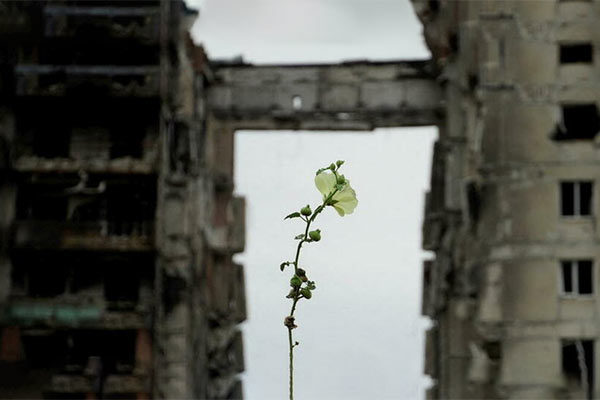Alexej Ovchinnikov
Each month, the UWEC editorial team shares highlights of recent media coverage and analysis of the Ukraine war’s environmental consequences with our readers. As always, we welcome reader feedback, which you can leave by commenting on texts, writing to us (editor@uwecworkgroup.info), or contacting us via social networks.
Russia’s latest attack on Ukraine’s energy network
In late March and early April 2024 Russia renewed its campaign of mass attacks on Ukraine’s energy network. From April 8–11 alone, two thermal power plants, six electrical substations, two energy facilities, one gas, and one oil storage facility were hit by missile strikes. The Trypilska thermal plant, located just outside Kyiv, was destroyed. It is one of Ukraine’s biggest heating facilities.
According to representatives of Ukraine’s largest energy company DTEK, six thermal power plants have been hit over the past few weeks, with five of them sustaining serious damage. Returning them to operation will require time and resources, and there is a high probability that it will not be possible to restore the power grid before the start of the next heating season in the fall. These missile attacks have already led to a series of blackouts across the country: Kharkiv, Ukraine’s second-largest city, was left without power and heat for several days after attacks in late March.

As Elena Pavlenko, president of the Dixi Group analytical center, explained in an interview with BBC Ukraine, in the last few weeks the Russian army has altered its tactics. Instead of mass bombardments, they have begun to conduct more precise strikes on specific targets. And while previously their aim was to cut off power-generating regions from the rest of the country by disrupting power lines, they are now seeking to carry out attacks that will cause general disruption to the energy grid itself, destroying thermal power plants and major substations. Pavlenko also pointed out that the attacks may also be aimed at seeking out weak spots in the air defense.
It is not only Russia’s tactics for attacking energy facilities that have changed: there is a cynical and cruel dimension to the way it now targets Ukraine’s civilian infrastructure using missiles. Several attacks are often carried out on one site within a short space of time in order to increase the number of victims. This is exactly what happened in mid-March in Odesa, when a team of rescuers who had arrived on the scene of a fire that had broken out as a result of an initial missile attack were hit by a secondary strike. Repeat attacks are also being carried out against already restored energy facilities.
The energy network is also suffering in occupied areas of Ukraine. Following a recent drone attack (which, according to the results of an investigation by British analysts McKenzie Intelligence Services, may have been a false-flag operation by the Russians), the last operating power unit at the occupied Zaporizhzhia nuclear power plant was put into cold shutdown, in response to recommendations by the International Atomic Energy Agency (IAEA). Today all six of the plant’s power units are in cold shutdown, although, as the agency’s director general Rafael Grossi points out, the situation remains unstable. The frontline is not far away, and IAEA representatives at the plant say that explosions can be heard from the station itself.
The destruction of civilian infrastructure and the potential threat of air strikes on nuclear power plants increase the risks of another environmental disaster in Ukraine. The bombardment of oil depots and thermal power plants results in air, soil and water pollution, while the ongoing attempts to repair damaged facilities require additional resources. In addition, the use of repeat strike tactics causes fire patrols to act with greater caution, with a knock-on effect on the quality of firefighting and responses to emergency calls. When it comes to nuclear power plants, the greatest danger is posed by spent nuclear fuel storage facilities, which run the risk of becoming accidental or special targets during attacks.
Why decentralizing the system is the solution to energy security
If Russia continues with its tactics of firing missiles at large thermal power plants, hydroelectric power stations, and other power-generating stations, then Ukraine will obviously be faced with a choice: either to restore the centralized carbon-based power network, which can always be destroyed again, or to move to a more decentralized energy system based on energy efficiency principles and the use of renewable energy sources.
The idea of decentralization is being actively promoted by the Ukrainian organization Razom We Stand, which is also campaigning for the strengthening of sanctions against Russian hydrocarbon fuels. On 21 March 2024, the organization joined forces with E3G, Berlin Economics, and Low Carbon Ukraine Project to hold an event titled “Rebuilding Ukraine’s Power Sector with Green Technologies: Opportunities for German-Ukrainian Cooperation.”
Specialists from Razom We Stand have prepared a policy paper titled “Prospects for the Ukrainian Electric Power Industry for 2023-2024: Investments in Old Coal-Powered Plants or New Decentralized Green Generation?” The document highlights a number of advantages that modernizing the energy system and abandoning centralized, coal-based energy units would bring. These advantages include energy security, and achieving sustainable development goals, adaptation to climate change, as well as the development of new green technologies.
“Every crisis creates an opportunity, and the war damage sustained by Ukraine’s energy system can provide the opportunity to build back better,” said Pavel Bilek, deputy director of the “Low-Carbon Ukraine” project, speaking at the event. “Replacing its damaged coal plants with renewable and storage technologies and boosting interconnectors with the EU will now help continue to improve Europe’s energy security and fight climate change,” added Pieter de Pous from E3G.
According to Maksym Bevz, head of the Renewable Energy and Green Recovery group at Razom We Stand, in order to completely move away from coal-powered generation by 2034, Ukraine will need 12 gigawatts of new installed capacity and $17.2 billion in investment. For a country whose economy has suffered significantly from the Russian invasion, such projects are only possible with the financial support of partners from other countries.
In any case, restoring Ukraine’s energy grid will require a huge investment. Kyiv will make a decision this year on whether the country’s energy network will continue to be based on large thermal power plants, hydroelectric power stations, and other units that are attractive targets for attack, or on a more extensive decentralized power-generation system lacking critical facilities as such.
Environmental organizations are taking an active role in projects for the green restoration of Ukraine, especially the development of energy-efficiency projects
The war may still be going on, but projects for rebuilding Ukraine are not only already being discussed, but are being implemented. At a recent conference on the energy efficiency of rebuilding Ukrainian cities, the Kyiv-based environmental organization Ecodiya (“Ecoaction”) and Berlin Economics presented a study titled “Green Recovery of Housing Stock: A Technical and Economic Analysis for the Town of Bucha.”
Bucha is a small satellite town northwest Kyiv. Before the war, the town was seen as an up-and-coming suburb, and many young families moved here to live in multi-story apartment blocks and growing numbers of single-family homes. During the full-scale invasion of spring 2022, Bucha and nearby Irpin were the scene of intense fighting on the approaches to Kyiv, which resulted in a significant portion of the town being destroyed. Bucha also acquired a tragic notoriety as the site of a massacre of civilians by occupying Russian troops in March 2022.
The study, which is freely accessible (in Ukrainian) online, makes the case that if homes in Bucha are rebuilt or new buildings are constructed according to a “minimum needs” principle, it will be possible to reduce the amount of natural gas used for heating by 45%, while the “Near Zero Energy Building” scenario will allow consumption to be reduced by up to 75%.
As researchers note, increasing energy efficiency levels will not only make homes more energy-independent, but also to reduce emissions of greenhouse gases, thereby contributing to the goal of achieving climate neutrality.
“Our research has shown that any recovery projects must be realized in accordance with high energy efficiency standards, such as nZEB, which will become mandatory for new construction in Ukraine from 2027,” says Anastasiia Horbach, an energy policy expert from Ecodiya. “Complying with them will lead to enormous savings in energy resources and costs, which Ukrainian municipalities will then be able to effectively use for their own sustainable development. In the national context this will make a major contribution to the state’s energy security and the decarbonization of the economy, and will also create new jobs.”
Naturally, energy-efficient construction projects will come at a higher cost than conventional construction. However, the period needed to recoup the initial investment for a project like this is naturally affected by the degree to which energy consumption is reduced. Taking reduced gas tariffs into account, this period ranges from 27 to 33.6 years. In the case of more realistic energy tariffs, the payback period falls to 15.3 years under the “Minimum Needs” scenario and to 19.4 years under the “Near Zero” scenario.
Ecodiya has also joined the Ukrainian network “Vikno Vidnovleniya” (Recovery Window), whose goal is to bring together journalists, experts and leaders from local communities to rebuild the country. As part of the project its participants are planning to describe the processes of recovery in different regions of the country, ensure that these processes are green and socially sustainable, develop the most effective and modern recovery projects, and allow for the participation of environmental organizations.
Main image source: glavcom.ua







